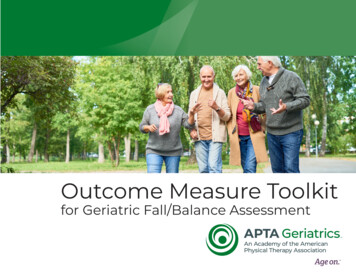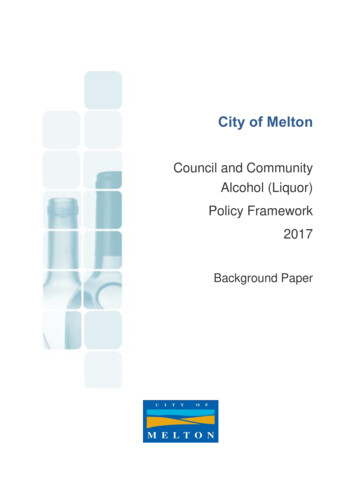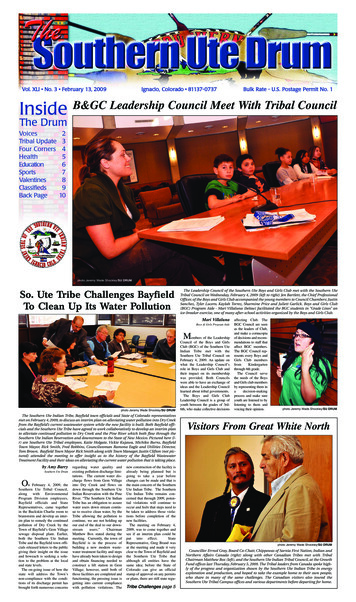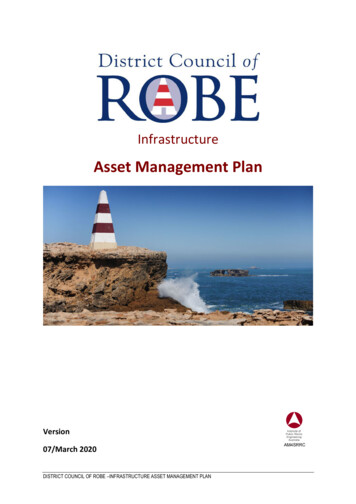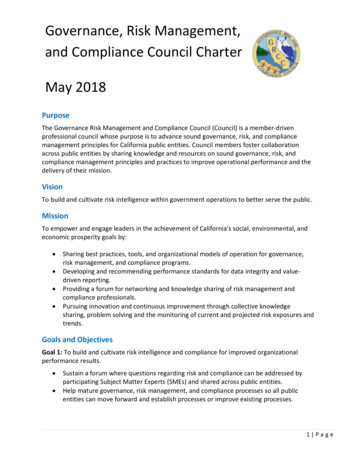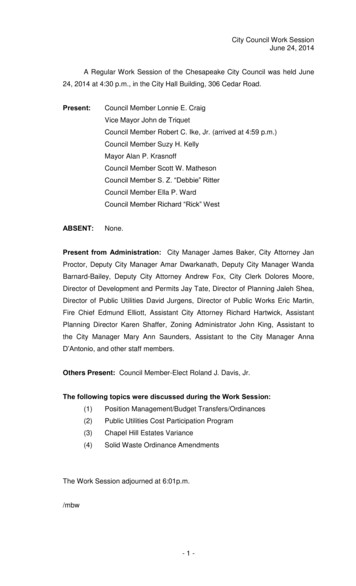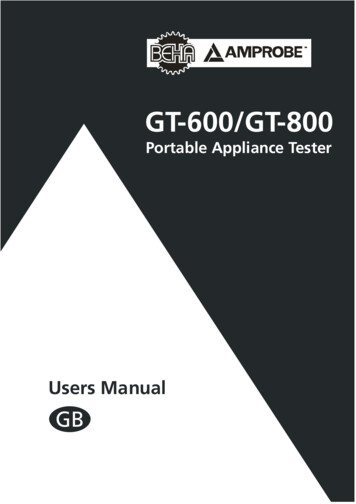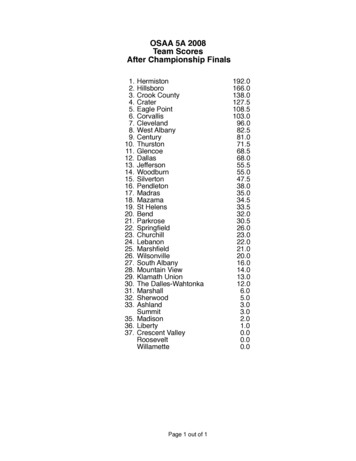
Transcription
Council on InstructionFall Policy WorkshopJuly 15, 2020Dr. Rachel BatesAssociate Vice Chancellor forEducational Partnerships
PUBLIC AGENDAThe Oklahoma State Regents for Higher Education haveidentified college completion as their No. 1 goal and areworking to increase the number of degrees and certificatesearned in Oklahoma.
Contents PART 1: History of Math Success Initiative PART 2: System Wide Initiatives PART 3: Building on the Change Student Assessment and Remediation
PART 1TimelineOctober 2011: Joined Complete College AmericaIncrease the number of degrees andcertificates by 67 % by 2023April 2012: Remedial Reform SummitSeptember 2012: Mathematics Faculty ConferenceSeptember 2013: Math Success Group Planning MeetingPART 3 Completion ConferenceApril 2015: Higher EducationMarch 2016: Co-requisite at Scale ConferenceApril 2017: Designing Math Pathways WorkshopApril 2017: OK Regents approved recommendationsSeptember 2017: Math course developmentFebruary 2018: Advising and Mathematics Pathways WorkshopFebruary 2018: Revise gateway mathematics coursesFall 2018: Implement new gateway mathematics coursesFall 2019: Continued development
PART 1Complete College America Goal to increase the number of degrees and certificatesearned in Oklahoma by 67 percent by 2023.Multiple initiatives:oInstitutional Degree Completion Plans/Academic Planso15 to FinishoMath Success InitiativeoReverse TransferoCooperative Agreement ProgramsCCA Summit:oInstitutional teams - professional developmentoWebinar series focused on initiatives
PART 1
PART 1Remedial Reform SummitIn 2012, OSRHE held a Remedial Reform Summit andMathematics Faculty Conference to discuss success rates inremedial and gateway mathematics courses. Remediation:oo40% of post-secondary students require remediation.60% of students entering community colleges requireremediation.o23% of students complete gateway course within two years.o11% of students graduate within three years.
PART 1Mathematics InitiativeLack of student success in mathematics has been identifiedas a significant barrier to achieving this goal.Oklahoma State Regents focused attention on mathematicssuccess by addressing the following goals:
PART 1RemediationPreliminary data show that more students are being placedinto co-requisite courses or alternative gateway courses.
PART 1Co-RequisiteThe Student Assessment and Remediation policy has recently beenrevised. These revisions have been approved by the Admission,Retention and Transfer Committee and were posted as part of April’sCOI committee report.Student Assessment and Remediation policy 3.20“Corequisite Support” is a process in which students who are belowcollege-ready in math, English or reading enroll in a gateway generaleducation course and receive additional non-credit academic support.The non-credit academic support may include, but is not limited to, anadditional course, tutoring, an online lab, and peer study groups.
PART 1Math Success GroupThe Mathematics Success Group, which consists of 35mathematics faculty, department chairs and teachereducators, began meeting in 2013 to develop a strategic planand obtained feedback from state and national groups.Priorities of the strategic plan included:1.Improve preparation of high school students and collegetransition;2.Reform remediation;3.Improve course placement; and4.Create multiple math pathways based upon meta-majors.
PART 1MPC ProjectIn November 2015, the Mathematics Pathways to Completionprogram of the Charles A. Dana Center at the University of Texas atAustin invited Oklahoma to join five other states and receive supportand consultation in pursuing math pathways for the State System. Oklahoma drafted a statewide, multi-year plan to guide long-termimplementation of math pathways;Oklahoma math faculty successfully created four gateway generaleducation courses;100% of higher education institutions have implemented at least two mathpathways; andContinued efforts are in place such that at least 50% of programs will bealigned to the appropriate math pathways.
PART 1Recommendations1.2.3.4.5.Establish statewide college meta-majors Significantand corresponding math pathways,Progressensuring transferability across institutions;Increase student engagement and theteaching of applications in gateway mathclasses;Increase support for important academicsuccess skills in gateway math classes;Provide faculty and advisor professionaldevelopment and resources; andImprove student preparation, includingSignificantefforts in K-12 education and remediationProgressreform.
PART 1Recommendations1.2.3.4.5.Establish statewide college meta-majorsand corresponding math pathways,ensuring transferability across institutions;Increase student engagement and theteaching of applications in gateway mathclasses;Increase support for important academicMIPsuccess skills in gateway math classes; 2019-2023Provide faculty and advisor professionaldevelopment and resources; andImprove student preparation, includingefforts in K-12 education and remediationreform.
PART 1Math PathwaysOklahoma institutions have implemented alternativegateway mathematics courses – alternatives toCollege Algebra.
PART 2Contents PART 1: History of Math Success Initiative PART 2: System Wide Initiatives PART 3: Building on the Change
PART 2System Wide Task Forces/Initiatives Complete Jobs OKCollege Americafor the FuturePromise ReachHigher DualCredit/Concurrent Education Highschool mathematics alignment
PART 3Contents PART 1: System Overview and Related Information PART 2: System Wide Initiatives PART 3: Building on the Change
PART 3PlacementIn 2015, OSRHE approved a revised assessment andremediation policy with two significant changes fromprevious policies.1.Identify assessments that more accurately describe a student’schance at success in entry-level courses.2.Allow remediation to be offered through a variety of mechanisms,including the co-requisite model.As of 2019, more institutions are implementing multiplemeasure (i.e.; high school GPA, degree of study) todetermine course placement for mathematics & English.
PART 3Advising Strategies Each institution has had to rethink student advising practices andpolicies. Efforts to develop degree maps that clearly defineprescribed curricula vs exploratory majors is ongoing work.Academic Program Approval Policy Section 3.4: All required courses for a degree must be clearly listed. Institutions must providetransparency in all degree requirements in accordance with HLC, institutional,and/or programmatic accreditation standards. For guidance, see ProceduresHandbook.
PART 3Building on Change – Degree Alignment Our goal is to develop a clear alignment of mathematic pathways todegrees (across institutions leading to state wide alignment).Identify one default or recommended gateway math requirementbased on the meta-majors determined by the regionaluniversity/college.
PART 3Building on Change – Degree AlignmentResearch shows that students who complete a college-level mathcourse within their first academic year are more likely to earn apostsecondary credential.Unfortunately, few of today’s students actually hit this important mark.One reason for the gap is that many institutions use College Algebra asthe default math placement for their students, despite the fact thatnational math faculty leaders believe the course should be usedprimarily as preparation for Calculus.
PART 3Building on Change – Math OptionsGateway mathematics courses should reflect students’ programs ofstudy – in many cases, that course will not be College Algebra orPrecalculus. With new Math Pathways, there is no shortage of relevantmathematics, and broad consensus now exists in the Americanmathematics community that relevance and rigor are hallmarks ofgood mathematics education.Uri Treisman – Executive Director, Charles A. Dana Center
PART 3Building on Change – Math OptionsGateway mathematics course options include: Quantitative Reasoning – Exploration of various topics designed toexpose student to mathematical problems within numerous disciplines.Liberal Arts mathematics course.Functions and Modeling – Study of equations, functions and modelingdata. Agricultural, business, life/health sciences or social science majors.Course Descriptions and Student Learning Outcomes
PART 3Building on Change – Math OptionsGateway mathematics course options include: Elementary Statistics – Introduction to statistics includes descriptivestatistics, summary statistics, probability and distribution.Algebra for STEM – Study of equations and functions. Suitable as thepreparation for Calculus.Common Titles:College AlgebraPre-Calculus
PART 1Common Degree DefaultsFunctions & ModelingAccounting NSU OPSU OSU OU UCOBusinessAdministration NSU OPSU OSU OU UCOEcon SE OSU OU UCOFinance NSU OSU OU UCOMarketing NSU OSU OU UCO
PART 1Common Degree DefaultsQuantitative ReasoningArt CU ECU NSU SEOSU SWOSU OPSU OSU OU USAOArt History CU ECU NSU NWOSU RSU SEOSU SWOSU OPSU OSU OUEnglish CU ECU LU NSU NWOSU SEOSU SWOSU OPSU OSU OU USAOForeign Lang NSU NWOSU SEOSU OSU OUHistory CU ECU NSU NWOSU RSU SEOSU SWOSU OPSU OSU OU USAOMusic CU NSU NWOSU SEOSU OPSU OSU OU UCO USAOTheater CU NSU SEOSU OSU OU USAO
PART 3Building on Change – CorequisiteOK public institutions of higher education have met the following goals: 100% of all remedial students within the state attend an institution thatoffers at least one co-requisite mathematics course;100% of all public institutions of higher education offer at least one corequisite mathematics course;Oklahoma public institutions of higher education have incorporated theuse of multiple measures to adequately support students with curriculardeficiencies in mathematics; andCompletion rates in gateway Math/English courses will continue to bestudied and analyzed for potential modifications.
PART 3Building on Change – High SchoolOSRHE and OKSDE continue to work with the Southern RegionalEducation Board and the College and Career Math Readiness course. Project: High School to College Mathematics PathwaysGoals: The Mathematics Success work team charged with developingsystematic, strategic conversations between high schools andcolleges.
PART 3Building on Change – CCMRCollege Career Math Ready is a free course designed for high school seniorswho have completed Algebra I, Geometry, and Algebra II, and need atransition course to get them ready for college-level coursework.The course emphasizes understanding of mathematics concepts rather thanmemorizing procedures. By engaging students in real-world applications,College Career Math Ready develops critical-thinking skills that students willuse in college and their careers.CCMR at SDE: https://sde.ok.gov/ccmr#OKMathReady
PART 3Building on Change – CCMRCCMR Training Workshops are being developed and plannedpost COVID-19.CCMR at SDE: https://sde.ok.gov/ccmr#OKMathReady
PART 3Building on Change – ICAPAs high schools begin to implement theICAP, colleges and universities arecurrently investigating ways to implementthe ICAP as students enter into highereducation.(Eportfolio – high school transcripts – career exploration)
PART 3Building on Change – High SchoolOklahoma is participating in the Conference Board of theMathematical Sciences (CMBS) Forum project. The focus of this projectis to bridge the gaps between high school and college mathematics. Project: High School to College Mathematics Pathways: PreparingStudents for the FutureGoals: To help OSRHE and OKSDE create policies and practices formathematics instruction that contribute to successful completionwithout reducing quality.
PART 3Building on Change – High SchoolMathways to ExcellenceBased on their expertise and experience, the leadershipteam has identified five categories of primary problems thatneed to be addressed to ensure students are sufficientlyprepared for the transition from high school to college bymeans of aligning standards and expectations betweensecondary and post-secondary education.
PART 3Building on Change – High School1.Lack of mathematics curriculum alignment between K-12and post-secondary.2.Lack of preparation for college math.3.Inconsistent and potentially ineffective placementpractices across the state system.4.Lack of equitable access to AP and concurrentopportunities for all students.5.Lack of coherent mathematical pathways for students.
Student Assessment and Remediation3.20 Student Assessment and Remediation3.20.1 Purpose Assessment of students fulfills two purposes:1.2.Improvement of teaching and learning; andAccountability and institutional effectiveness. Course Placement General Education Program Outcomes Student Satisfaction
Student Assessment and Remediation3.20 Student Assessment and Remediation3.20.4 Entry Level Assessment and Course Placement Students scoring below the ACT subject score minimum level will bereviewed with additional information, as approved by the StateRegents, to determine the level of readiness for college-level coursework. Another test is not required.Institutional entry level assessment programs should include anevaluation of past academic performance, educational goals, studyskills, values, self-concept and motivation. A test is not required.
Student Assessment and Remediation3.20 Student Assessment and Remediation3.20.4.B Basic Academic Skills Requirements Students must begin remediation of basic academic skillsdeficiencies during the first semester and continue untilprepared for college-level course work in the respectivesubject area.Students scoring below the ACT subject score minimum levelwill be reviewed with additional information, as approved bythe State Regents, to determine the level of readiness forcollege- level course work or successfully completedevelopmental education in the subject area.
Student Assessment and Remediation3.20 Student Assessment and Remediation3.20.5 General Education Assessment This assessment is designed to measure the student'sacademic progress and learning competencies inareas such as communication, critical thinking,mathematics, reading, and writing.More than the general education course selection inthe first half of the degree program.
Student Assessment and Remediation3.20 Student Assessment and Remediation3.20.6 Program Learning Outcomes Select instruments to assess learning outcomes for eachdegree program. Should assess higher level thinking skillsin applying learned information. When available andappropriate, nationally standardized instruments will beused.All findings will be reported in program reviews asindicated in Academic Program Review policy. Resultsfrom nationally standardized instruments will bereported in the Annual Student Assessment Report.
Student Assessment and Remediation3.20 Student Assessment and Remediation3.20.7 Student Engagement and Satisfaction Student and alumni perceptions are important in the evaluation ofacademic and campus programs and services. Such perceptions arevaluable because they provide an indication of the students' subjectiveview of events and services which collectively constitute theirundergraduate experiences.Evaluations of student satisfaction can be accomplished via surveys,interviews, etc. Resultant data will be used for the improvement ofprograms and services.Current practices include NSSE, CCSSE, BCSSE, FSSE, SSI, SRI, IDEA StudentRatings of Instruction, SENSE.
Student Assessment and Remediation3.20 Student Assessment and Remediation3.20.8 Assessment Plan and Reporting To achieve the purposes of this policy and to accomplish effective andinnovative State System assessment, every institution will maintain a currentassessment plan that includes a minimum of the assessments required in thispolicy.The plan will be submitted to the State Regents for approval every five yearsor when substantive changes are made. Report all changes to staff todetermine if substantive.
Student Assessment and Remediation3.20 Student Assessment and Remediation3.20.8 Assessment Plan and Reporting Annually, institutions shall submit to the State Regents astudent assessment report containing informationrelated to this policy and the institution’s approvedplan. Refer to the Academic Affairs ProceduresHandbook for details regarding the reportingrequirements.Due December 4, 2020.
Thank you for joining me today.Dr. Rachel Batesrbates@osrhe.edu405.225.9168
policies. Efforts to develop degree maps that clearly define prescribed curricula vs exploratory majors is ongoing work. Academic Program Approval Policy Section 3.4: All required courses for a degree must be clearly listed. Institutions must provide transparency in all degree requirements in accordance with HLC, institutional,



